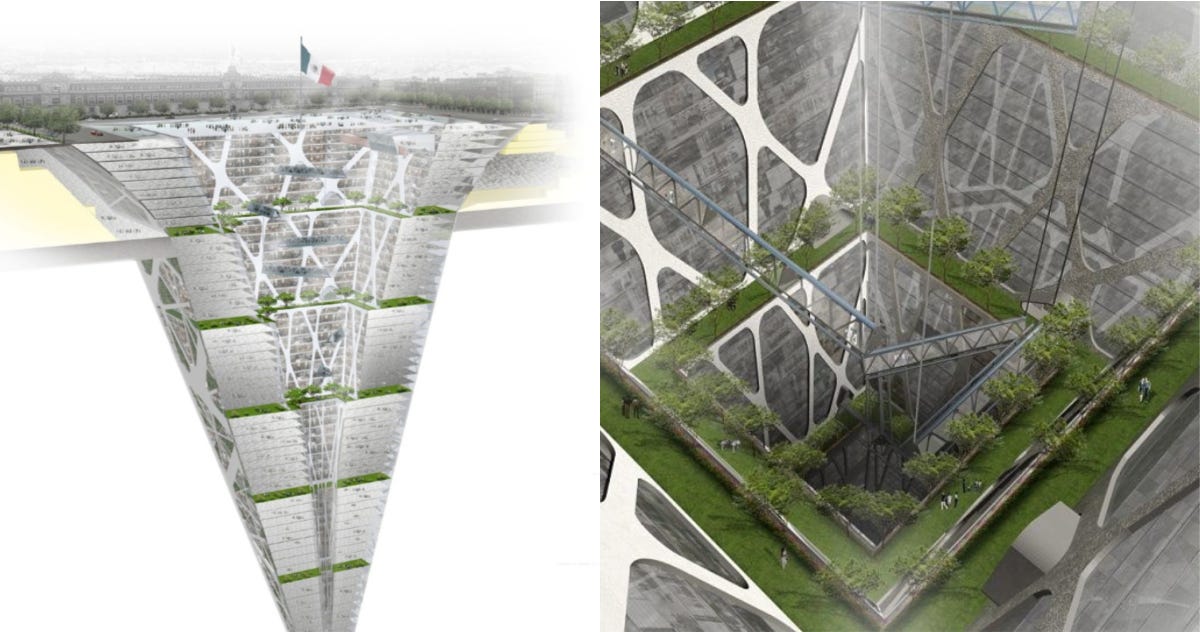With the problems of overpopulation and declining land resources challenging urban centers globally, creative architectural designs are receiving more attention. Among these innovative designs is the earthscraper, a skyscraper turned upside down that digs deep into the earth rather than soaring above the ground. Earthscrapers hold the promise of transforming urban development by tackling space limitations, environmental issues, and security threats. But are these underground wonders really the solution to overpopulation and urban disorder? This article discusses the possibility of earthscrapers as a sustainable solution while considering their advantages, challenges, and viability.
Understanding Earthscrapers
Earthscrapers are multi-story buildings constructed beneath the surface of the earth for the purpose of creating habitable areas for dwelling, business, and leisure use. In contrast to conventional subterranean constructions like parking structures or basements, earthscrapers consist of permanent residential areas with access to contemporary facilities. The idea came into limelight with projects such as BNKR Arquitectura's 65-story earthscraper for Mexico City's Zócalo square, though it is still mainly conceptual.
The first ever finished earthscraper, the InterContinental Shanghai Wonderland, is a testament to what this design can do. Constructed in an abandoned quarry, this hotel has 16 levels underground and proves how vacant land can be utilized for livable spaces. Earthscrapers are designed to maximize land usage in high-density cities while saving surface-level environments and heritage sites.
Advantages of Earthscrapers
Effective Use of Land
Earthscrapers take up little surface area but offer a lot of usable space below ground. This makes them perfect for overcrowded cities with little land to spare. With an estimated 68% of the world's population likely to reside in urban centers by 2050, earthscrapers would be able to house increasing populations without further encroaching on green belts or current infrastructure.
Stable Underground Temperatures
One of the strongest points of earthscrapers is that they are able to regulate temperature stably. Only one meter under ground, temperature variation every day falls to ±5°C, and at five meters, it is less than ±1°C. This stability cuts down energy needed for heating and cooling, which makes earthscrapers more eco-friendly than conventional buildings.
Structural Stability
In contrast to skyscrapers that need large amounts of materials to resist wind forces and maintain stability, earthscrapers take advantage of the natural stability of the surrounding soil and rock structures. This natural stability lowers the cost of construction and resource consumption while improving safety in natural disasters such as earthquakes or cyclones.
Protection from Natural Calamities
Earthscrapers provide better protection from severe weather conditions because they are located underground. In areas where there are tornadoes or hurricanes, these buildings would be safe shelters for the people.
Problems Confronting Earthscrapers
Ventilation and Lighting
Providing comfortable living space underground is a major challenge. Providing proper ventilation and natural lighting necessitates sophisticated engineering techniques like skylights, solar tubes, and air circulation systems.
Psychological Impact
Habitat or working beneath the surface could have psychological impacts on residents based on minimal natural light and outdoor exposure. Overcoming such issues will need considerate planning with the integration of features such as green spaces and open common spaces.
Environmental Hazards
Constructing far below the ground could interfere with natural resources like minerals or aquifers. Furthermore, some rock structures could release harmful materials such as radiation, thus requiring strict site selection and measures of mitigation.
High Construction Costs
The earthscraping excavation process is technically sophisticated and costly. Sophisticated technologies must be employed in structural reinforcement, waterproofing, and energy conservation systems—issues that may cap widespread use.
Impact on Overpopulation
Overpopulation aggravates challenges such as the lack of resources, environmental deterioration, unemployment, and poverty. By providing extra living space without growing horizontally or vertically upwards on the surface, earthscrapers may relieve city crowding while maintaining ecological balance. Furthermore, their energy-saving design concurs with sustainable development objectives meant to fight climate change—a timely issue associated with overpopulation.
But earthscrapers themselves will not eradicate overpopulation; they have to be accompanied by an overall policy combining family planning, education toward sustainable habits, and fair allocation of resources. They are successful at solving the space problem but very expensive, perhaps out of the reach of the poor—again, something in need of a policy response.
Future Prospects
Earthscrapers are a radical leap in architectural technology but are still in their early stages as a practical solution. Effective application will rely on surmounting technical hurdles through innovation in engineering and materials science. Public acceptance will also be key; raising awareness of their advantages could lead to mass adoption.
Urban areas with acute space shortages—like Tokyo or Mexico City—are strong contenders for ground-breaking earthscraper schemes. Governments and developers will need to work together to develop low-cost models that achieve functionality as well as sustainability.
Conclusion
Earthscrapers provide a compelling look toward the future of city dwellings by marrying creative building design with functional solutions to overpopulation and ecological problems. Their capacity to maximize land use while maintaining a small environmental footprint renders them an attractive solution to the conventional skyscraper. But whether or not they work is contingent on overcoming technical obstacles, psychological issues, and financial restraints.
Though earthscrapers by themselves cannot solve overpopulation or urban mayhem completely, they are a vital part of the solution in building sustainable cities for generations to come. By incorporating this idea into overall urban planning schemes, we can get closer to a world where living above ground—and below ground—becomes a harmonious reality.
Soiurce: Wikimedia, Vedantu, Infinity Learn, novatr.com
